It is always refreshing to find a curriculum my kids can use independently. To finish out our language arts studies this year, my twins and I took time to review Home School Navigator Reading and Language Arts Curriculum. The online elementary curriculum incorporates reading, writing, grammar, and vocabulary. Students can begin using the program as early Kindergarten or jump in at the appropriate level at any time.
My twelve year old daughters are a bit advanced for their age, so I wondered, Would a program like this benefit them? I placed the girls in the highest level, Indigo, which is designed at a fifth grade reading level. In addition to trying out the literature and writing components of the program, the girls also worked on an Interactive Notebook while reading and studying the novel Holes.
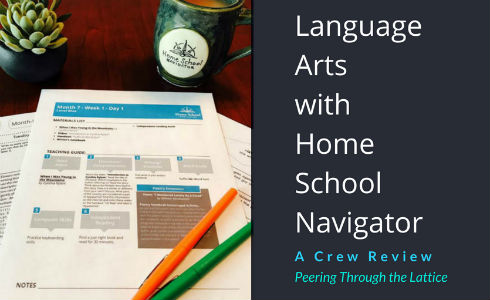
Parent Introduction Video
I watched an introductory video to familiarize myself with the program’s overall structure. Since the overview video is not designed for a particular grade level, it discusses elements (such as a “word wall”) which do not apply to the Indigo level my twins are working on.
I am glad I did not skip the video though, since it includes some helpful advice:
- Remember that you are in charge.
- You do not have to do everything.
- Feel free to bump kids up or down a level as necessary.
Getting Started
After becoming familiar with the way the curriculum is set up, it is easy to use. A Weekly Guide for parents provides a quick overview of the entire “buffet” of material for each day. I cross off unnecessary sections. For instance, my girls already have a strong foundation in grammar, so they do not need to complete those assignments. Likewise, they are already typing many stories and assignments on the computer, so I am selective with Writing assignments and allow the girls to completely skip the Computer Skills section.
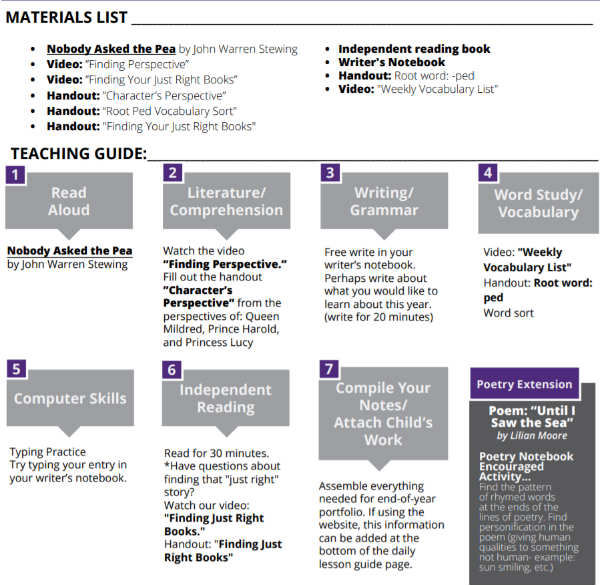
On the girls’ assignment sheets, I record the lesson number and the sections they need to complete (i.e. 1.3.1 Lit/Comp, Writing). Each student has her own login and password to access the lessons, so the twins can complete all of their work independently using the website and the worksheets it provides.
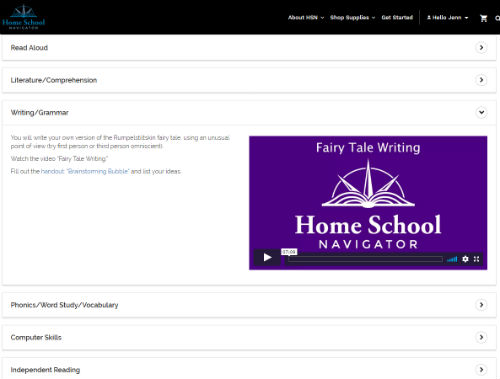
Each girl logs in, chooses the appropriate day, then presses the arrow to the right of each section I have assigned. Her specific assignment is detailed in the description that drops down. Instructions are clear and often accompanied by a video for further clarification.
We are focusing our attention on the Literature/Comprehension assignments since our prior English curriculum focused mainly on grammar. I want my girls to learn literary terms like irony, foreshadowing, and plot, since this vocabulary will serve them well in high school, college, and life in general. In fact, the girls were learning terms like these within the first month of lessons on Home School Navigator.
I also want my girls to develop their writing skills. Following along with the Writing assignments in the first month, the girls enjoyed creating their own versions of “Rumplestiltskin.”
What About Books?
I was a bit skeptical that an online program could teach literature without requiring me to buy any books. Home School Navigator includes videos of each book being read aloud, although in some cases only excerpts pertinent to the assignment are included. One of my daughters loves following along with these videos while the other prefers to read the book on her own. So far, about half of the books are easy to find and check out from the local library.

Twin Perspectives on the First Month
The first four weeks of the program cover fairy tales, which are primarily presented using picture books. Is the choice of books too juvenile for the twins? Apparently not. “Good choice,” announces the younger twin, “I like fairy tales.”
The second week of the curriculum challenges students to find books written from different viewpoints. According to the younger twin, “It’s fun, and I think it’s helped me enhance my writing a bit more. I can now write in third person limited point of view,” a perspective she was previously “not at all” aware of.
Although we relied on the video readings during the first two weeks since the books were not available in our local library, we were able to get our hands on the main book for week three. It made a huge difference for both girls. “I like having the physical books; it’s fun!”
My younger twin was really excited when week three rolled around and they started reading The Rumplestilskin Problem, which includes several retellings of the classic fairy tale. “It’s getting really fun, and the stories are getting to more of my level. Before, the books were picture books, but now they’re different, and I actually read them” (as opposed to watching the video read-aloud).
The older twin found it challenging to summarize one of the stories she had read. “It’s hard to put things in my own words in complete sentences sometimes.” I appreciated the graphic organizer worksheet Home School Navigator provided and was grateful that the lesson video guided her through the process.
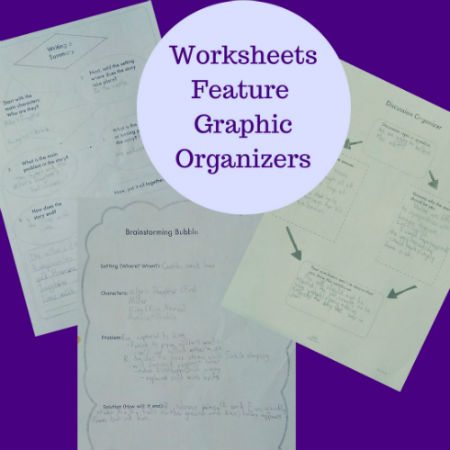
The younger twin finds that “the activities are really easy, and the instructions are easy to understand. If I don’t have clear instructions, I’ll have questions, and I’ll wonder if I’m doing it right or not.” The website includes instructional videos that clearly explain each concept and assignment.
“I really enjoy the videos; they’re fun to watch because they’re videos!”
I wondered whether using a level designed for fifth grade would discourage my seventh-grade twins or motivate them. The younger twin assures me, “It did motivate me a little bit, but it didn’t make much of a difference because I was already motivated—I love writing.”
The older twin has mixed feelings: “I have to say that at some parts it’s a teeny bit hard. It’s a bit discouraging.” However, “the fact that I’m doing a lower level also motivates me because that means it’s most likely easier than seventh grade.” She points out, “Some parts we don’t really need because we already know [them] well, but some parts are the right level for us.” She adds, “I usually don’t do much writing, so the writing is a bit more challenging for me.”
Would this level of work be appropriate and enjoyable for most fifth graders? Both twins it would be.
Preparing for Month Two
I expected to be able to move through the material more quickly with my girls since they are older, and this is indeed possible when focusing only on the literature assignments. When I peeked at month two, I noticed that there was a major writing assignment that correlates with the literature. My girls could certainly benefit from extra writing practice, but including the writing section every day probably means completing the lessons as they are paced in the curriculum instead of at an accelerated rate. With only two weeks left in our school year, I decided to set aside the bulk of the curriculum.
Instead, we spent the final two weeks completing the Independent Reading unit based on the book, Holes, which I was able to check out of the library.
Holes Book Study
The interactive book study on Holes is scheduled to be completed over an entire month if used with additional language arts resources. Since it was our only language arts component, we spent just two weeks on it. Each morning, the girls read the assigned chapters and then completed activities from the Interactive Notebook. In the afternoon, we reviewed their answers together.
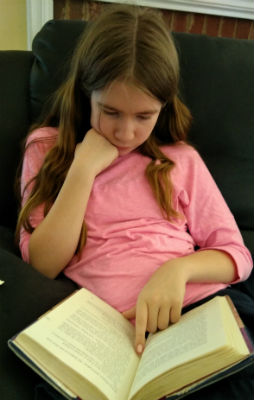
Although these activities are designed to be cut out and glued into a notebook (much like lapbook pieces), the girls opted to write their answers digitally by annotating the PDF file online in lieu of the hands-on work.
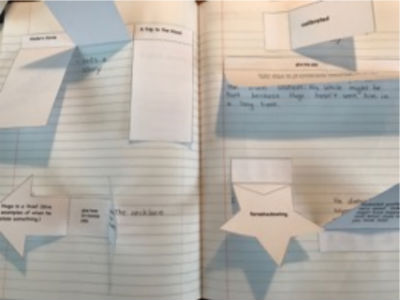
I offered the girls the option of using presentation software to creatively present their answers. However, I did not take the time to set that up for them, and they were not motivated to do it on their own, preferring an easy alternative. They may have been just as happy with a standard worksheet, especially if I allowed them to fill it in online. Families accustomed to lapbooking and notebooking would probably enjoy the format of these interactive notebook pages.
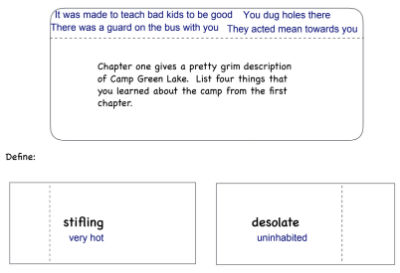
My daughters enjoyed reading the book and completing the study guide. My older twin comments, “It helps us remember stuff…it forces you to remember things…it’s fun to review it. I like to review with my sister the part that we wrote down.” She insists she would “much rather do it on the computer.” Although she likes the worksheets included in the formal literature study, she insists, ”I just like this more.”
Her sister adds, “It’s really fun! The book is very interesting; the study guide makes it more interesting. There’s nothing that I can’t like about it.” She enjoyed writing her answers on the computer but recommends, “Arts and craftsy (people)…should print it out.”
She was surprised at the difficulty level and content of the story. “The story is pretty dark; I would suggest seventh or eighth graders read it, not fifth graders. It would make more sense to middle schoolers than to elementary schoolers… In seventh grade it makes complete sense to me, and I enjoyed it more than I would if I was younger.”
”It has a lot of depth in it, and I like that. It makes you think, Oh! I never thought of that!”
The book study pages draw attention to details they may not have noticed on their own—aspects like foreshadowing, making guesses about what things meant, and even the volume of dirt that must be removed for each hole the boys in the story dug.
Overall Impression
I am so glad we had a chance to try out Home School Navigator. Aside from this review opportunity, I probably would not have given the program a second glance. It has been exciting to see my twin daughters dive into literature. What I love most, though, is how easy the class is to implement immediately and adapt to meet our needs.
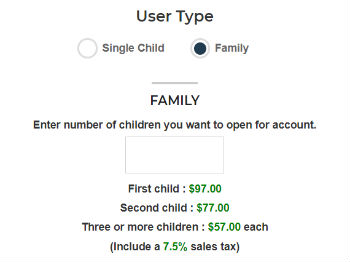
The program is very affordable and well worth the money. It includes practically everything you need for an entire year of language arts study. The video below offers a brief overview of what is included.
Homeschool parents provide:
- library books
- a internet-connected device (the site is mobile- and tablet-friendly)
- printer (or have your child annotate the PDF worksheets)
- time to review and grade your child’s work.
I anticipate using portions of Home School Navigator to supplement the girls’ eighth grade curriculum, as they are truly benefiting from the gentle introduction to literary analysis. I expect the correlated writing assignments will give them the practice they need to develop skills in this area as well.
My twelve-year-old daughters are using the Indigo level of Home School Navigator and focusing on just a few of the areas of instruction offered. If you have younger children or are interested in learning more about other features such as Vocabulary/Word Study or Poetry Extension, click here to read reviews from other Crew members, many of whom utilized the lower levels.
